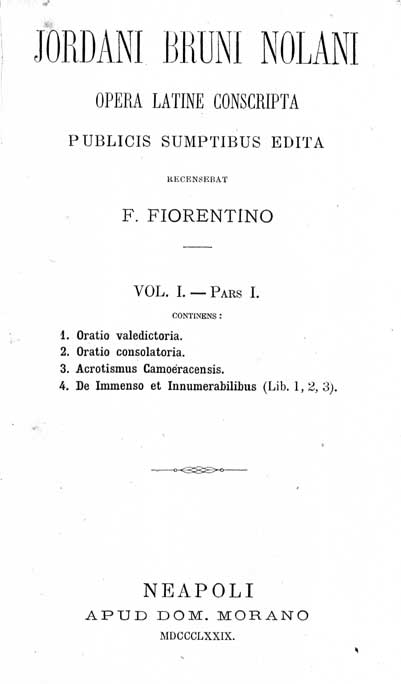|
Camoeracensis Acrotismus seu rationes articulorum physicorum adversus Peripateticos Parisiis propositorum, Viterbergae, apud Zachariam Cratonem, 1588, in Jordani Bruni Nolani Opera latine conscripta publicis sumptibus edita. Recensebat F. Fiorentino, vol. I, pars I, Neapoli, apud Dom. Morano, 1879, pp. 53-190. The Camoeracensis acrotismus has been published by Giordano Bruno at Wittenberg in 1588 at the printing-office of Zacharias Krafft. The term ‘acrotismus’ is a neologism of Brunian coining by distorsion of the original Greek title of the Aristotelian Physics: Physiche akroasis. The title stands for: discourse or lecture at the Collège de Cambrai at Paris, where ‘discourse’ means that the text has been presented to an audience. The Camoeracensis acrotismus represents in fact a new edition of the Centum et viginti articuli de natura et mundo adversus Peripateticos, a work which presents the Brunian theses against the Aristotelian writings Physics and De caelo, proposed and defended (by the scholar Jean Hennequin and by Bruno himself) the 28th of May 1586 at Paris, on the occasion of the first encounter of a public dispute which should have taken place at the Collège de Cambrai even in the following days, but which had been suspended because of the violent contestations of the radical Brunian theses as early as during the first encounter. In contrast to the Articuli, in the Acrotismus the articles to discuss are reduced from 120 to 80 (combining some of the articles), but it differs also for providing the articles with rationes (explanations) for to illustrate and specify the reasons of the polemics against the Aristotelian and Peripatetic physics and cosmology. (Of the 80 articles comprised in the Acrotismus, the first 50 articles discuss theses Aristotle proposed in his Physics, while the next 30 articles refer to the work De caelo). In the Acrotismus, the Articuli de natura et mundo are preceded by dedicatories to Henry III, King of France, to the Rector and the philosophers of the University of Paris, followed by an extensive introductory discourse (signed by Jean Hennequin, but in fact written by Bruno) under the title Excubitor, which signifies him (the philosopher himself) who urges the others to rouse themselves from the torpor of traditional doctrines. The Excubitor is followed by a catalogue of the articles against Aristotle and by a catalogue of the Pythagorean and Platonic assertions defended by Bruno. After these introductory sections, there follow the articles proper with their respective ‘explanations’. The Camoeracensis acrotismus can be considered as a ‘manifesto’ of the new natural philosophy and, at the same time, as a radical criticism of the Aristoteliean and Peripatetic conception of nature, also with reference to an ‘ontology’. In this sense, Bruno, with regard to a physical concept of Being and of unique and infinite substance, refers to the Platonics, but also to the Presocratic thinkers. In his work, Bruno is looking for a connecting point between the Presocratic “antiqua vera filosofia” and the acquisitions of the science of his time, particularly in reference to the Copernican theory. Click here to go directly to the text Editor's Note In the transcription of the text, implicit parts of speech have been inserted between square brackets (for instance “Ibi [Aristoteles] notat”). “j” has been represented as “i”. |
|
|
The Camoeracensis acrotismus is a latin text containing Bruno's chief astronomical ideas already known through La cena de le Ceneri and De l'infinito. Bruno suggests a system even more anti-Aristotelian than in his preceding works. Since God is infinite, Bruno insisted, He must necessarily be the cause of an infinite world. This assumption denies any cosmological hierarchy and involves an absolutely uniform matter in the heavens.
